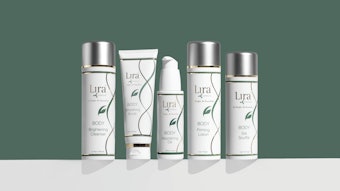
Part I of this two-part series, which ran in the March 2008 issue, began our discussion on the process of glycation. Part II will take a look at some of the biological havoc glycation can produce.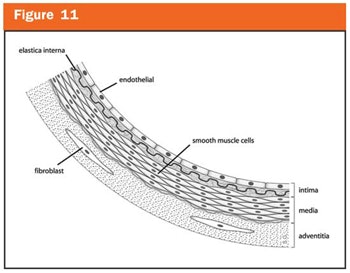
Physiological consequences
Glycation affects the cardiovascular system in a very large way. Tissues and organs that have a slow turnover or are more permanent in the body are most affected by glycation. The cardiovascular system; connective tissue and skin; nerve tissue; and renal tissue are major targets. If you examine an artery, either large or small, you will see some of the target tissues in the blood vessels. See Figure 11.
All blood vessels have the same basic structure. There are three layers from inside to outside. The tunica intima is a single layer of endothelial cells that are quite fragile. There is a thin layer of subendothelial connective tissue immediately under the tunica intima that contains elastin fibers. The next layer is the tunica media, which is the thickest layer and contains muscle cells, collagen and many elastin fibers. The muscles of the tunica media control the diameter, or caliber, of the artery. Finally, there is the tunica adventitia, which consists of connective tissue, nerves and small blood vessels that actually supply the large blood vessel itself with nutrient blood flow. See Figure 12 for the locations of these layers.
The importance of understanding the anatomy of the blood vessels is to appreciate the amount of elastin in the arteries and see it as a site to which glycation molecules will latch. When this happens, the caliber of the artery is decreased, and its ability to respond to the changes and needs in blood pressure is markedly decreased. This property of mechanical changes in blood vessels is called compliance. There is also a lot of collagen in the arterial walls, which, through the action of AGE molecules, can cross-link with each other and with other molecules, such as the plasma proteins albumin and globlulins.2, 3
Renal system. The kidney is a highly vascular organ that functions as a filter which eliminates waste and some toxins, but the key mechanism relies on adequate, but not excessive, blood pressure. AGE molecules can damage not only the vascular part of the kidney, but also the filtration system, namely the membrane system that is so critical to the selective passage of many different molecules. AGEs now have a strong association with the genesis of diabetic renal complications.4, 5
Neurological and ocular systems. AGEs have been reported to play an important role in the pathogenesis of Alzheimer’s disease. In one study using immunohistochemical localization of AGEs, AGE proteins and other abnormal proteins were found in senile plaques and in neurofibrillary tangles in Alzheimer’s disease and other neurodegenerative diseases.6
In the eye, retinopathy is associated with reduced vision or blindness, depending on the type. AGEs are associated with diabetic retinopathy, although just how this happens as a pathogenic mechanism is poorly understood. One of the agents needed for retinal growth and function is known as the vascular endothelial growth factor (VEGF). In a recent study, it was found that AGEs increased in the retinal pigment epithelial cell layers of a rat retina. The AGE-induced increase in VEGF levels was correlated with the dose- and time-dependency of exposure to AGEs, but the effect could be inhibited by antioxidants. AGEs may participate in the pathogenesis of diabetic retinopathy through their ability to increase retinal VEGF gene expression.7
Glycation in the cortex and nucleus of the human lens was found in the cataracts of both nondiabetic and diabetic older individuals when studied for the amount of early and late AGEs. There was a definite increase in early and late glycation in the lens nucleus when compared to the cortex of both the nondiabetic and diabetic older individuals, although these changes were much larger in the diabetic group. Glycation of the lens proteins is a generalized feature that is seen more frequently in the diabetic lens compared to senile lens proteins. The obvious reason is the increased glucose level seen in the diabetic individual.8
Skin. After all of this complex stuff, if you read this far, you are probably asking “When will skin be covered?” Well, here you are. Fortunately, glycation does not occur largely in the dermis before age 35, but then it really gets going and, along with intrinsic aging, it progresses rapidly. The long-lived tissues are the target of AGEs, and they bind tenaciously to collagen and elastin, more avidly to elastin. This can be seen in the upper dermis, which is the realm of elastin. In a paper by Mizutari et al, a section of a skin biopsy is shown from the face of a 91-year-old revealing tangled masses of elastotic material in the upper dermis.e When this material was stained for elastin using immunological stains, large amounts of this elastotic material was seen.f Further staining of this area with specific immunological stains detected the AGEs in the area, seen in the third photograph of this paper.9
Much of the fine processes involved with glycation remain to be discovered. Glucose and other simple sugars combine with proteins as a first step, but sugars also combine with amino acids and other compounds to start the process. As an example, fructoselysine, which is formed by glycation of the amino acid lysine, can be oxidatively cleaved to form smaller reactive compounds, such as carboxymethyl lysine (CML) and pentosidine.10 The net result is elastin and collagen that cannot be catabolized, or broken down, and new proteins are formed to replace them. Because of this, the skin becomes stiff and yellow-brown with age. A key concept is that it is not only glycation that produces these effects; for these products to undergo oxidation to form the smaller, often more reactive Maillard chemicals, such as CML and pentosidine. One other comment on this topic: There is some nonsense in the population about vitamin C, or ascorbic acid, being a major cause of oxidative stress and causing free radicals. There is no strong evidence to support this, and there have been no reports where it has been associated with glycation or oxidative stress. Supplemental vitamin C may be used without fear of making things worse.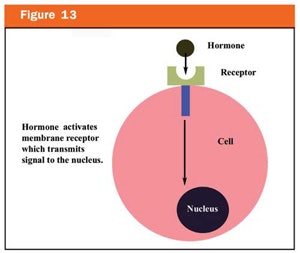
The esthetician needs to understand that, as clients age, they will have more of a risk of glycation-initiated damage. The glucose level is the major culprit in initiating the formation of AGEs and the end product of glycation is cross-linked, stiff, nonfunctioning collagen and elastin. A sad commentary is that collagen has a half-life of 15 or more years in the skin, so the turnover is very slow and the AGE damage is very difficult to remove.g As a comparison, the collagen in the aorta has a half-life of 100 years. Besides instructing your clients in good dietary practices, they must also be strongly admonished to quit smoking. One more basic science topic needs to be covered before prevention and treatment of glycation can be discussed, and that is the subject of AGE receptors on cells.
Receptors for Advanced Glycation End-products (RAGEs)
A very basic biological concept is that of agent and receptor, or ligand and receptor. A ligand is any compound that binds to another molecule, such as a receptor. For example, every peptide needs a receptor on the cell if it is going to have an effect on that cell. Since it is water-soluble, the peptide cannot enter the lipid cell membrane, so it uses a receptor on the cell membrane that can transfer its message to the nucleus. In Figure 13, this system is labeled with all parts identified.
The RAGE receptor is known as a toll-like receptor, which are pattern-recognition receptors very similar to the immunoglobulin receptors, which are key mediators of your response to bacteria or viruses, for example. The process goes along a pathway on which the macrophage first ingest the bacteria and produce cytokines that initiate inflammation by activating the immune system. This is a fundamental mechanism in most biological species. The AGEs, glycated proteins, lipids or even nucleic acids form a group of patterned ligands that can interact with RAGEs and initiate cellular signaling programs that include activation of NF-kB, a major inflammatory agent. Unlike binding directly to a long-lived protein, such as collagen or elastin, these soluble AGEs act as ligands on RAGEs and stimulate the inflammatory process.
NF-kB is a critical factor in inflammation, and inflammation is suspected to be a major factor in aging. Here is a very brief overview of NF-kB. It is a transcription factor; that is, it takes processed signals from the cell membrane, or cytoplasm, into the nucleus and turns on specific genes that promote inflammation. It is found in just about every cell in the body and can be activated by many types of stimuli, such as free radicals, ultraviolet irradiation, oxidized products, bacterial and/or viral antigens. Within the immune system, it is a key step in controlling the response to infection. On the down side, when it is not regulated properly, NF-kB can lead to cancer, inflammatory connective tissue diseases, septic shock, viral infection and even neurological malfunction.
Just so you appreciate the importance of glycation, both insoluble and soluble forms are unfriendly. The insoluble form cross-links protein and can add to proteins, such as enzymes, and to lipids to denature them, making them not only nonfunctional, but also harmful to the cells and tissues. The soluble AGEs react with RAGEs on the cell membrane and initiate the activation of NF-kB, which, in turn, sets off a nuclear cascade of inflammatory agents—like a microscopic nuclear war.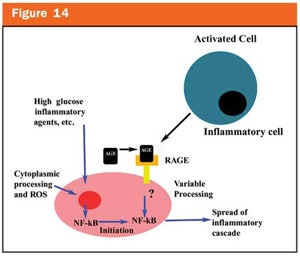
This may be the first time you have come across the concept of NF-kB, but it will not be the last time if you continue to read in the world of science, particularly the science of skin care. There is one research paper that reports the rapid induction of collagenase and elastase by UV light, and how these enzymes can be produced within minutes to hours after sun exposure. It also reports about the effect of retinoids in preventing this damaging effect. The cellular summary of the AGEs-RAGEs action can be seen in Figure 14. By binding to the cell receptor, these AGE molecules might affect cellular function. Remember that RAGE is a member of the immunoglobulin family of cell-surface molecules and is able to recognize three-dimensional structures, such as proteins in the form of sheets and fibrils, rather than a sequence of specific amino acid structures, as do true immunoglobulin receptors. RAGEs, therefore, can act as multiligand receptors; that means it is able to interact with not only AGEs, but also with other proteins, such as S100-proteins.h One special feature of activated RAGEs is the induction of a sustained proinflammatory transcription factor NF-kB by overriding the normal autoregulatory loops.
RAGEs can sustain cellular activation and function as master switches, and, by doing this, they convert short-lasting proinflammatory responses into long-lasting cellular dysfunction. In Figure 14, glucose and other initiators of inflammation, such as cytokines, induce the formation of ROS and thereby turn on NF-kB. Inflammatory cells release AGEs, and ROS promote intracellular AGEs. All of these actions, along with the activation of NF-kB, result in more RAGE expression, which will increase the number of RAGE-binding sites required to sustain NF-kB. This is a very important factor about AGEs and RAGEs. RAGEs are driven by a setting in which ligands accumulate in an early proinflammatory type of environment, which can be seen in diabetes mellitus, atherosclerosis, neurodegenerative disorders, rheumatoid arthritis and chronic inflammatory bowel disease.
Glycation damage in skin cells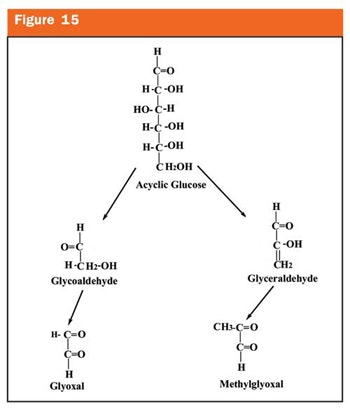
Two glycation end product carbonyls that are quite plentiful in the body are known as methylglyoxyl and glyoxyl. You will recall that carbonyls are by-products of the early Maillard reaction and they are very nasty reactive compounds.
Figure 15 shows how both glyoxal and methylglyoxal can be produced from glucose without going through the whole Maillard reaction. These reactions proceed with oxygen, so antioxidants are not helpful in preventing them. They are very important because they are found to interfere with many biochemical substances and reactions, one in particular is DNA. Both glyoxal and methylglyoxal damage DNA in intact cells. Glyoxal is able to produce DNA strand breaks and methylglyoxal is responsible for many DNA protein cross-linking that results in nuclear condensation and the inactivation of some sections of DNA. There are many biological reactions caused by this pair of culprits, but this gives you an insight into the dangers they can pose.11, 12
There is some adverse effect of glycation on keratinocyte function. It has been reported that glycation products diminish the effectiveness of collagen type I binding to keratinocytes and this defect reduces the migration ability of keratinocytes in the epidermis, but it does not affect the proliferative capacity of keratinocytes.13 This finding could relate to impaired wound-healing. Glycation has also been connected to the accelerated aging of keratinocytes. Placing keratinocytes in tissue culture with a solution of glucose at 100 mM, or glyoxal at 0.1 mM in three days will change the biological characteristic of the cells from young keratinocytes to old, late-passage keratinocytes.i This is very significant because it indicates that a poor diet—one high in sugars—can markedly speed up the aging process.14 These are only a few of the adverse effects of glycation on skin. Bottom line: Glycation makes you older faster, and makes the skin look just plain awful.
What can you do?
You can start a therapeutic program to help your clients prevent further glycation. Start by looking at the foods they eat. Just about
The following discussion is based on a paper published in the Journal of the American Dietetic Association.15 Foods were prepared by the following methods and the quantity of glycation products determined per milliliter of food: boiled in water at 100°C (212°F), deep-fried at 180°C (356°F), oven-fried at 230°C (446°F) and roasted at 177°C (350.6°F).
The two AGE units determined were carboxymethyl lysine and carboxyethyl lysine. The levels of AGEs in these foods are tabulated in Table 1. The results of this study showed a clear relationship between AGE content and nutrient composition. Lipids and proteins had the highest content of AGEs, while carbohydrates contained the lowest amount. Processed food contained much higher levels of AGEs. For example, rice cereal contained 600 Kilounits (Ku)/serving, while toasted bread contained only 30 Ku/serving. The research workers attributed this difference to the system of processing. Many processed foods undergo a treatment in which they are heated to 446°F and may be subjected to high pressures for extrusion. These methods have been found to produce thermal degradation, dehydration and actual molecular rearrangement of fragments, which are known to promote glycoxides.16
It is interesting that the temperature at which food is cooked is more important than the time it is cooked. A chicken breast that has been cooked by boiling for one hour at 212°F has fewer AGEs—1,000 Ku, than a chicken breast broiled at 446°F for
15 minutes—5,250 Ku. The authors recommend a dietary program similar to that proposed by the American Heart Association. Basically, the diet consists of reducing high AGE-containing foods, such as full-fat cheese, processed meats and other highly processed foods, and add or increase low fat milk products, grains, fruits and vegetables. Obviously, high glucose intake is also a no-no. One of the problems in assaying these foods is selecting the AGEs to measure, which is no small task because there may be hundreds of these compounds.
When cooking foods, particularly meat, temperatures should be less than 250°C (482°F) and they should cook for less than one hour. When these limits are exceeded, more AGEs are produced. Processed foods should be used sparingly, as the temperatures used are high and mechanical stress can produce many AGEs. An example is some baby formula, which contains more than 100 times as many AGEs as breast milk or cow milk. Eating high AGE-containing foods will modulate the immune system, which can result in autoimmune disorders.17
Smoking and glycation. Cigarette smoke contains high concentrations of glycotoxins that pass from the lungs into the bloodstream. The glycotoxins are, in part, responsible for increased rates of atherosclerotic cardiovascular disease and cancer. Once they are in the bloodstream, the glycotoxins induce the formation of AGEs, which attach to the proteins of the vascular walls and initiate atherosclerosis. It is highly probable that these glycotoxins may react with DNA in the lungs and become a major factor in initiating lung cancer.18
How can you convey the dangers of smoking to your clients? Never accept a skin care client who smokes. Have them stop first, because they cannot be serious about skin care if they smoke. One thing is certain: You can promise your clients that they will have ugly skin in five to 10 years if they smoke.
Prevention and treatment. Prevention of disease is the key to staying young and healthy. To prevent or reduce glycation load, first start with diet. Begin with reducing the glycation-heavy foods you consume. Say you cut out 400 calories a day. In three months, you will lose 400 calories x 90 days/4,000 calories = 9 lbs. How much weight should you lose? Roy Wolford, who was the father of caloric restriction, talked about a set point that seems to be your weight as a teenager or young adult, or when you looked your best. Shoot for that. That is not hard to do if you just make a habit of eliminating high-calorie foods, or even reducing them. Next, select a diet that you know you can adhere to; one that reduces sweets to a minimum. Be careful of honey, for fructose is a more avid glycator than glucose.19 Microwaving may help, but most studies show they do not because of the high temperature of steam that they generate. The benefit may be in the short time the foods are exposed to heat.
Fiber helps to absorb glycation products, so eat whole fruits and vegetables. Also, consume fewer fried and broiled foods; more slow-cooked foods, such as soups and stews; more raw fruits and vegetables; a little more gnawing on bones; a good, firm apple a day; some grains and milk; low fat cheese; fish, such as mackerel, tuna, salmon and sardines; and eggs. Avoid high-sugar items, such as pies or rich cakes, doughnuts and high-temperature processed foods.
Supplements. There are a few supplements that help to prevent glycation from occurring. The ones with the best record are the following:
Aminoguanidine—150–300 mg a day, best taken with food. Higher dosages are usually required for diabetic patients, around 300–600 mg daily, or even higher,
since aminoiguandine last only four hours it should be taken in divided doses. It is best to consult with your physician before taking aminoguanidine since it tends
to deplete B-6.
Benfotiamine—100 mg twice a day
Carnosine—500–1,000 mg/day
Pyridoxamine—100 mg/day
Carnosine is a dipeptide consisting of alanine and histidine that has been shown to counteract free radicals and help prevent peroxidation of cell membranes. Pyridoxamine is a form of pyridoxine or vitamin B-6, but it does not have the side effects of B-6 and is an excellent glycation inhibitor.20 Benfotiamine is a lipid-soluble thiamine or B-1 vitamin. It also is an excellent glycation inhibitor. Aminoguanidine has a long use as a glycation inhibitor, but of late, there are some reports of low toxicity, mainly coupling with vitamin B-6.21 It cannot couple with pyridoxamine, however. It is widely used in animal studies with glycation products and has been shown to be very effective. The dosage for humans is 150–300 mg/day in divided doses. There are many suppliers for these products.
Even though glycation has been known about for more than 20 years, the information is only now becoming available to the general public, and very few doctors in the United States have heard of it. Antiglycation agents are widely used in Europe to treat both diabetes and heart disease. So far, the products on the market for topical treatment of glycation are few and not very effective. Actually, the extent of glycation in the skin can be measured with an instrument that measures a fluorometric chemical called pentosidine. Pentosidine accumulates in a linear fashion over time. A consumer can actually determine if a topical product is effective with this method and can monitor the progress of treatment in a client. The current instrument is only a research model that costs about $35,000, but as the treatment becomes popular, a more inexpensive version will become available. This could open a whole new era of skin care and anti-aging treatment.
AGE breakers
Once the glycation product is formed, it is hard to break because there are no natural enzymes in the body that can dissolve the bond. There are products developed that have been shown to be effective in breaking AGE-associated links. Alt-711 is one of these products that improved the vascular system of older Rhesus monkeys.22 Known now as C16, a second type studied in rats was found to restore diabetes-associated cardiovascular diseases. This product was also a thiazolium type similar to Alt-711.23 A third product uses a different approach; an enzyme specific for glycation called an amadoriase. There are actually two enzymes—fructosyl lysine oxidase and fructosyl lysine 3-phosphokinase—isolated from bacteria that are capable of breaking glycation link proteins.24 Although not commercially available or tested on humans, it presents a possible method that could be a great addition to future treatment modalities in anti-aging.
Summary
Glycation is the non-enzymatic joining of a sugar and a protein, or a lipid. It is a process that occurs naturally in foods, especially when cooked. The Maillard reaction is one of these processes that starts by forming a Shiff base and proceeds to forming multiple chemicals called advanced glycation end-products, or AGEs, that have adverse effects on a person’s biological processes. AGEs can link up with many proteins and denature them or alter them to be nonfunctional, cross-linked collagens, which is an AGE protein complex responsible for stiffness of the skin.
Skin collagen has a long half-life; these cross-linked forms do not go away and are not fully reversible at present. Elastin is another long-lived protein that is easily glycated and lasts a long time. Denatured elastin is associated with slackened skin. AGEs have cellular receptors known as RAGEs that initiate inflammatory reactions when activated by an AGE complex. These reactions tend to be chronic and are associated with arterial diseases, metabolic disorders and rheumatoid arthritis. Once they are started, the AGE-RAGE system will accelerate and perpetuate itself.
In the skin, glycation accounts for accelerated aging, yellowing and stiffness of the skin, and decreased circulation. Skin cannot look young and healthy with glycation products. Treatment is best started with prevention by diet control, reducing total calories, avoiding high sugar foods and not cooking at high temperatures. Supplements such as aminoguanidine, pyridoxamine, carnosine and benfotiamine are excellent glycation preventors. A new class of drugs called glycation breakers is being developed to correct the existing glycation protein complexes associated with many chronic diseases. They will truly be the youth drugs of the future.
REFERENCES
1. M Balter, Earliest Signs of Human-controlled Fire Uncovered in Israel. Science 304(5671), 663–665 (Apr 2004)
2. Vasdev et al, Role of advanced glycation end products in hypertension and arteriosclerosis: therapeutic implications. Cell Biochem Biophys 49(1), 48–63 (2007)
3. VM Monnier et al, Accelerated age related browning of human collagen in diabetes mellitus. Proc Natl Acad Sci 81, 583–587 (1987)
4. S Reinhard et al, Advanced Glycation End Products in End-stage Renal Disease and Their Removal. Nephron 87, 295–303 (2001)
5. ME Williams, Clinical studies of advanced glycation end product inhibitors and diabetic kidney disease. Current Diabetes Reports 4(6), 441–446 (2004)
6. S Nobuyuk et al, Advanced Glycation End Products in Alzheimer’s Disease and Other Neurodegenerative Diseases. Am J Pathol 153(4), 1149–1155 (Oct 1998)
7. M Lu et al, Advanced glycation end products increase retinal vascular endothelial growth factor expression. J Clin Invest 101(6), 1219–1224 (Mar 15, 1998)
8. AS Duhaiman, Glycation of human lens proteins from diabetic and (nondiabetic) senile cataract patients. Glycoconjugate Journal 12(5), 618–621 (1995)
9. K Mizutari et al, Photo-enhanced modification of human skin elastin in actinic elastosis by N(carboxymethyl) lysine. One of the glycation products of the Maillard reaction. J Invest Dermatol 108, 797–802 (1997)
10. DG Dyer et al, Accumulation of Maillard reaction products in skin collagen in diabetes and aging.
J Clin Invest 91, 2463–2469 (1993)
11. MJ Roberts et al, DNA damage by carbonyl stress in human skin cells. Mutat Res 522, 45–56 (2003)
12. J Zeng et al, Evidence for inactivation of cysteine proteases by reactive carbonyls via glycation of active site thiols. J Biochem 389, 196–205 (2006)
13. K Moritra et al, Migration of kerartinocytes is impaired on glycated collagen type I. Wound Repair Regen 13, 93–101 (2005)
14. U Berge et al, Sugar-induced premature aging and altered differentiation in human epidermal keratinocytes. Biogerontology: Mechanisms and Intervention 1100, 524–529 (2007)
15. T Goldberg et al, Advanced glycoxidation end products in commonly consumed foods. J Amer Dietetic Assoc 104, 1287–1291 (2004)
16. ME Camire, Chemical changes during extrusion cooking, Process-Induced Chemical Changes
in Food, New York, NY: Plenum Press (1995)
pp 106–119
17. M Peppa et al, Fetal or neonatal low glycotoxin environment prevents autoimmune diabetes
in NOD mice. Diabetes 52, 1441–1448 (2003)
18. C Cerami, Tobacco smoke is a source of toxic reactive glycation products. Proc Natl Acad Sci 94, 13915–13920 (1997)
19. B Levi and MJ Werman, Long-term Fructose Consumption Accelerates Glycation and Several Age-Related Variables in Male Rats. J of Nutrition 1442–1449 (1998)
20. JM Onorato et al, Pyridoxamine, an inhibitor of advanced glycation reactions, also inhibits advanced lipoxidation reactions. J Biolog Chem 275, 21177–211884 (2000)
21. KC Chang, Aminoguanidine prevents age-related deterioration in left ventricular-arterial coupling in Fisher 344 rats. British J of Pharmacol 142, 1099–1104
22. PN Vaitkevicius et al, A cross-link breaker has sustained effects on arterial and ventricular properties in older Rhesus monkeys. Proc Nat Acad Sci 98, 1171–1175 (2001)
23. G Cheng et al, C16 a novel advanced glycation endproduct breaker, restores cardiovascular dysfunction in experimental rats. Acta Pharm Sinica 12, 1460–1466 (2005)
24. X Wu and VM Monnier, Enzymatic deglycation of proteins. Arch Biochem and Biophys 419, 10–24 (2003)
Recent Articles by Peter T. Pugliese, MD:
Physiology of the Skin: The Impact of Glycation on the Skin, Part 1 (March 2008)
Parabens: Paradox or Paranoia (January 2008)
Recent webinars by Peter T. Pugliese, MD:
The Truth About Cellulite (April 15, 2008)
Related articles:
Triple Threat: Three Keys to Fighting Aging Skin by Diana Howard, PhD--June 2007
Related news items:
Too Much Sugar May Cause Wrinkles--November 13, 2007
Low Glycemic Diet Can Help Decrease Acne--November 20, 2007









